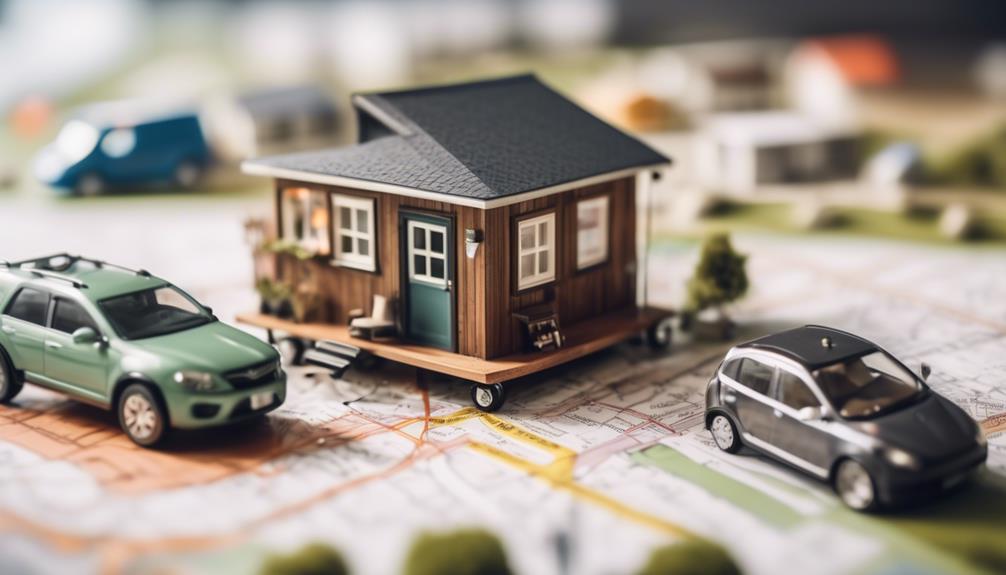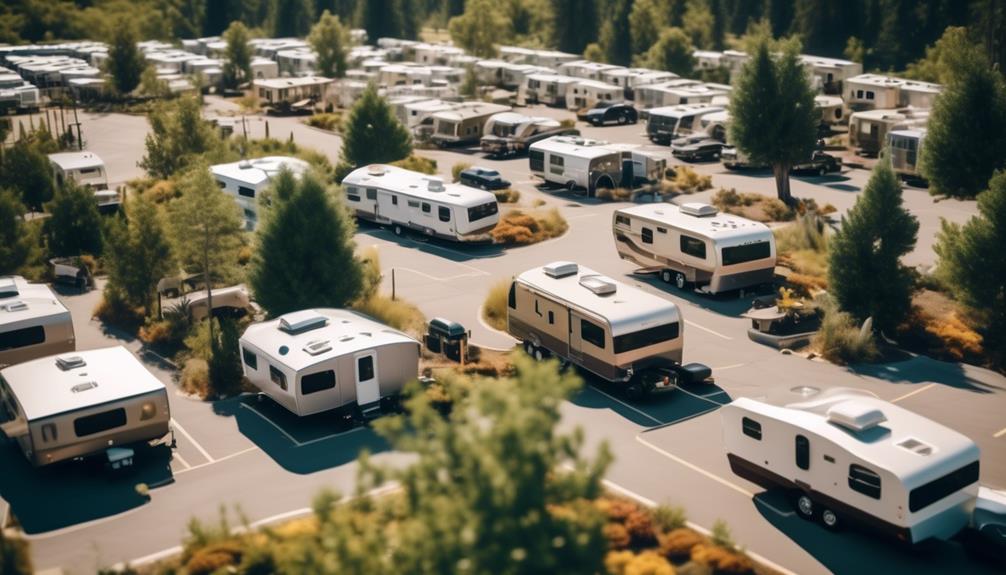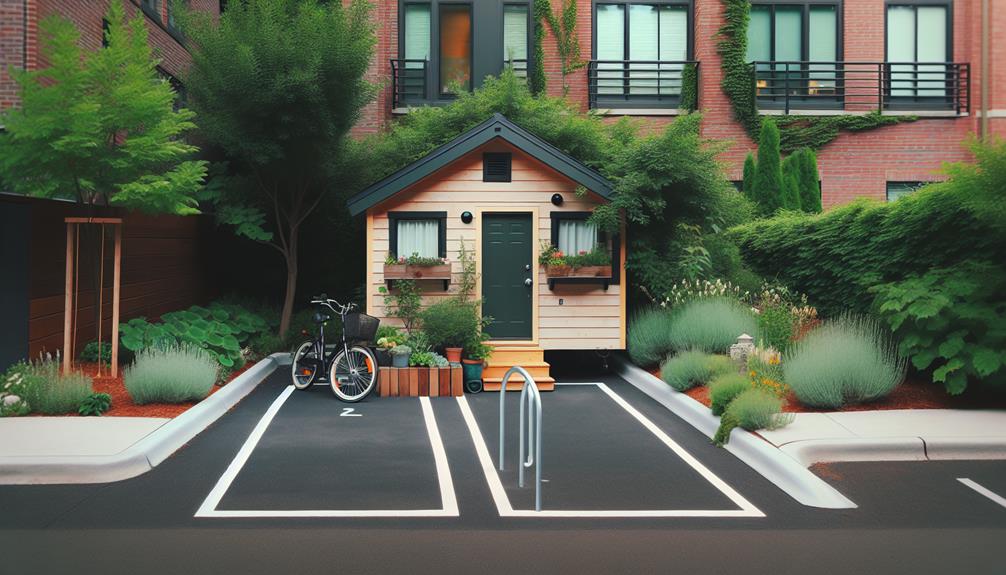You've scoured the earth, crossed deserts, and sailed the seven seas, yet finding a parking spot for your tiny home feels like a quest of mythical proportions. As you navigate this journey, you're not alone; the surge in tiny house living has many echoing your plight.
You're seeking a haven—a stable, legal, and practical place to anchor your diminutive dwelling. While friends and family might offer a temporary respite, zoning laws and community bylaws often dictate a more complex solution.
As you ponder your next move, consider the myriad of options available, from the welcoming arms of tiny house communities to the potential of private land leases. But before you set your sights on the perfect spot, there's a wealth of factors to weigh, such as accessibility, amenities, and, of course, the bottom line: cost.
Stay on this path, and you'll uncover the strategies that can turn the daunting into the doable.
Key Takeaways
- Research and understand zoning laws and building codes to ensure compliance for parking your tiny home
- Explore options for parking on private land, considering zoning compliance, landowner consent, and utility access
- Consider RV parks as a strategic option, ensuring your tiny home meets RVIA certification standards
- Utilize online resources and platforms to scout potential parking spots and connect with landowners
Understanding Zoning Laws

To navigate the complexities of parking your tiny home, you'll need to delve into the specifics of local zoning laws. These laws are the regulatory framework determining where and how your tiny abode can legally reside. Understanding these laws is vital to ensure that you're in compliance with local building codes. Zoning laws vary significantly, affecting which types of land—be it residential or commercial—are suitable for tiny house parking.
Strategically, you should research areas known for lenient regulations or even specific provisions for tiny house communities. By doing so, you're more likely to find parking spots that accommodate the innovative lifestyle you seek.
Exploring Private Land Options
Having established the importance of adhering to zoning laws, let's now examine the potential of parking your tiny home on private land, which requires navigating both landowner consent and utility modifications. As a tiny house builder or owner, you'll need to engage with landowners and clarify the innovative nature of tiny homes. Building a small home often means pioneering new ground, so be strategic in choosing locations that might be more amenable to your lifestyle—often, these are found outside city limits.
| Consideration | Private Land | RV Parks |
|---|---|---|
| Zoning Compliance | Varies widely | Generally compliant |
| Utility Access | May require mods | Typically available |
| Landowner Consent | Essential | Not needed |
| Long-term Stability | Depends on agreement | Usually secure |
Considerations for RV Parks

Why might RV parks serve as a strategic option for parking your tiny home, given their amenities and potential for long-term stays? As you navigate the tiny house movement, it's crucial to weigh the innovative solutions for tiny living, and RV parks present a viable strategy.
Here's what you need to consider:
- RVIA Certification: Ensure your tiny home meets the Recreation Vehicle Industry Association standards.
- Duration of Stay: Private RV parks often allow for more extended stays than public campgrounds.
- Park Regulations: Familiarize yourself with the rules specific to each RV park.
- Community Aspect: Living in tiny house communities within RV parks can offer a network and shared van life experiences.
Strategically evaluating these considerations can streamline your transition to a sustainable, mobile lifestyle.
Utilizing Online Resources
Leverage online platforms such as Facebook, Reddit, and Craigslist to efficiently scout potential parking spots for your tiny home. Delve into online classifieds and specialized groups like Tiny House Hosting to network with landowners open to hosting your first tiny house. Make sure to utilize tools like My Tiny House Parking for a curated list of locations amenable to tiny living.
This strategic approach includes tiny house communities and RV parks, ensuring you find the best tiny home parking solutions within the digital landscape.
When utilizing online resources, it's crucial to be analytical. Tailor your search to your specific needs for a tiny home. Consider employing Facebook Ads to target demographics in areas you wish to dwell, thus streamlining the process of securing an ideal spot.
Assessing Costs and Budget

Before committing to a parking spot for your tiny home, it's essential to meticulously analyze your budget, factoring in not only the monthly rent, which can range from $300 to $800, but also any additional costs for utilities and modifications.
When assessing costs and budget, consider:
- The up-front and ongoing expenses to Build a Tiny House in your chosen locale.
- Whether the house costs align with your financial planning, including long-term savings.
- The strategic partnerships with Home Builders that could affect your overall expenditures.
- How your home needs may evolve, impacting future budget adjustments.
Be thorough in your financial strategy to ensure your innovative lifestyle remains sustainable. Understand how much does it cost to maintain your tiny home's parking arrangement to avoid unexpected financial burdens.
Frequently Asked Questions
Where Can I Park My Tiny Home in Denver?
You'll need to navigate Denver's zoning regulations, tap into community networks, consider private land, and scrutinize legal considerations. Leverage parking apps and explore urban options for a cutting-edge approach to stationing your tiny home.
How Do I Find Space in My Tiny House?
To maximize your tiny house's interior, invest in space-saving furniture and multifunctional designs. Utilize vertical storage, hidden compartments, and wall-mounted appliances. Strategically planning lofted areas can also enhance your living space's functionality.
Where Can You Park a Tiny House in California?
In California, you can park your tiny house on legal lots complying with zoning regulations, explore backyard options, join community living spaces, or seek residential exceptions on agricultural land for innovative housing solutions.
Where Is the Cheapest Place to Put a Tiny House?
You'll find the most cost-effective tiny house spots in rural areas, where land sharing options abound. Navigating zoning laws is key; consider community farms, private land agreements, or boondocking spots for economic placement.
Conclusion
In your quest for a cozy nook to nestle your tiny abode, remember that navigating the legal labyrinth is crucial. Opt for verdant pastures with private landowners or join kindred spirits in tiny house hamlets. RV sanctuaries offer a haven, too, but weigh their codes.
Harness digital maps in your strategic search and balance your treasure chest wisely. In the tapestry of tiny living, each thread—legal, financial, communal—weaves the vibrant mosaic of your home's resting place.

